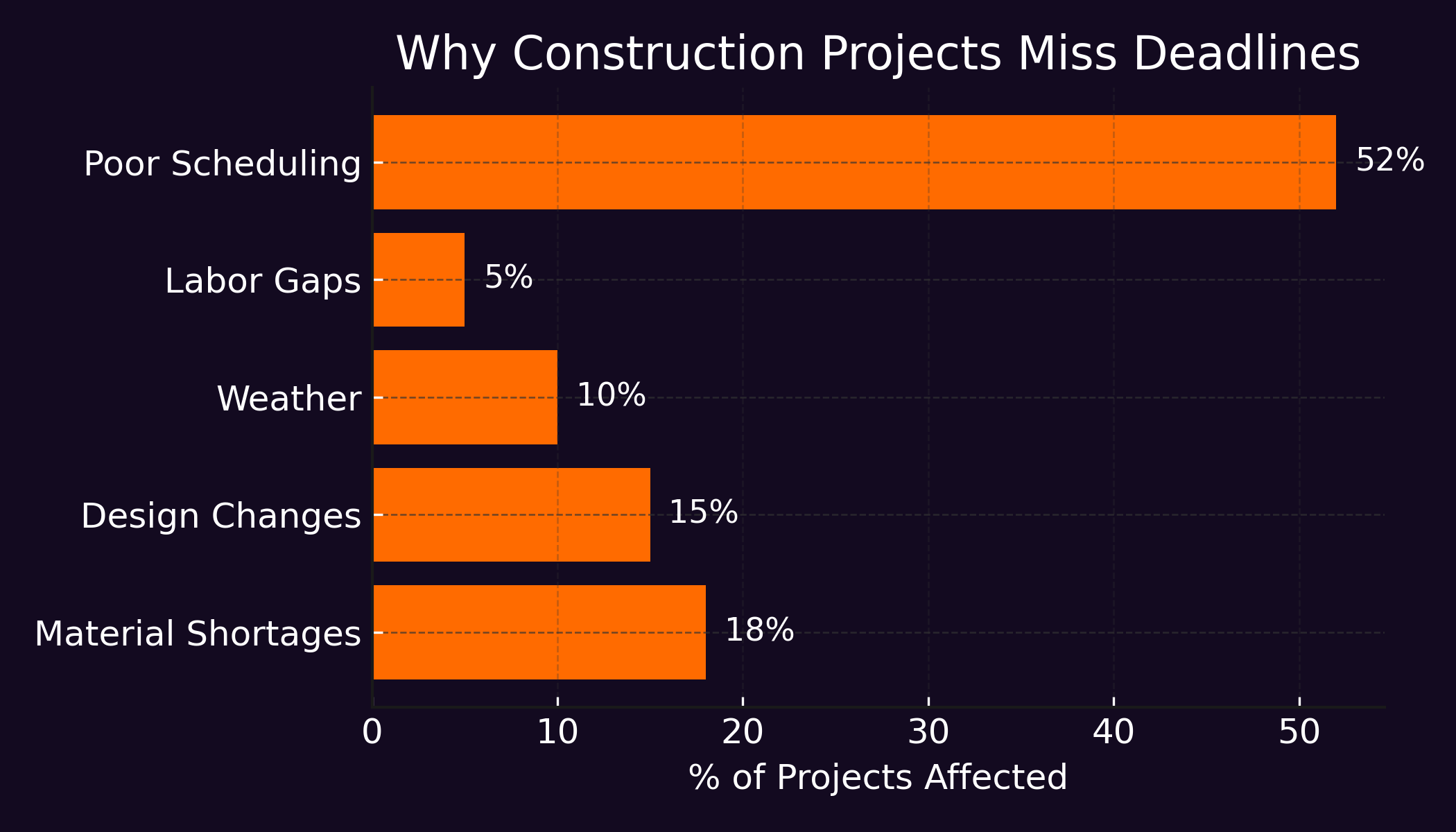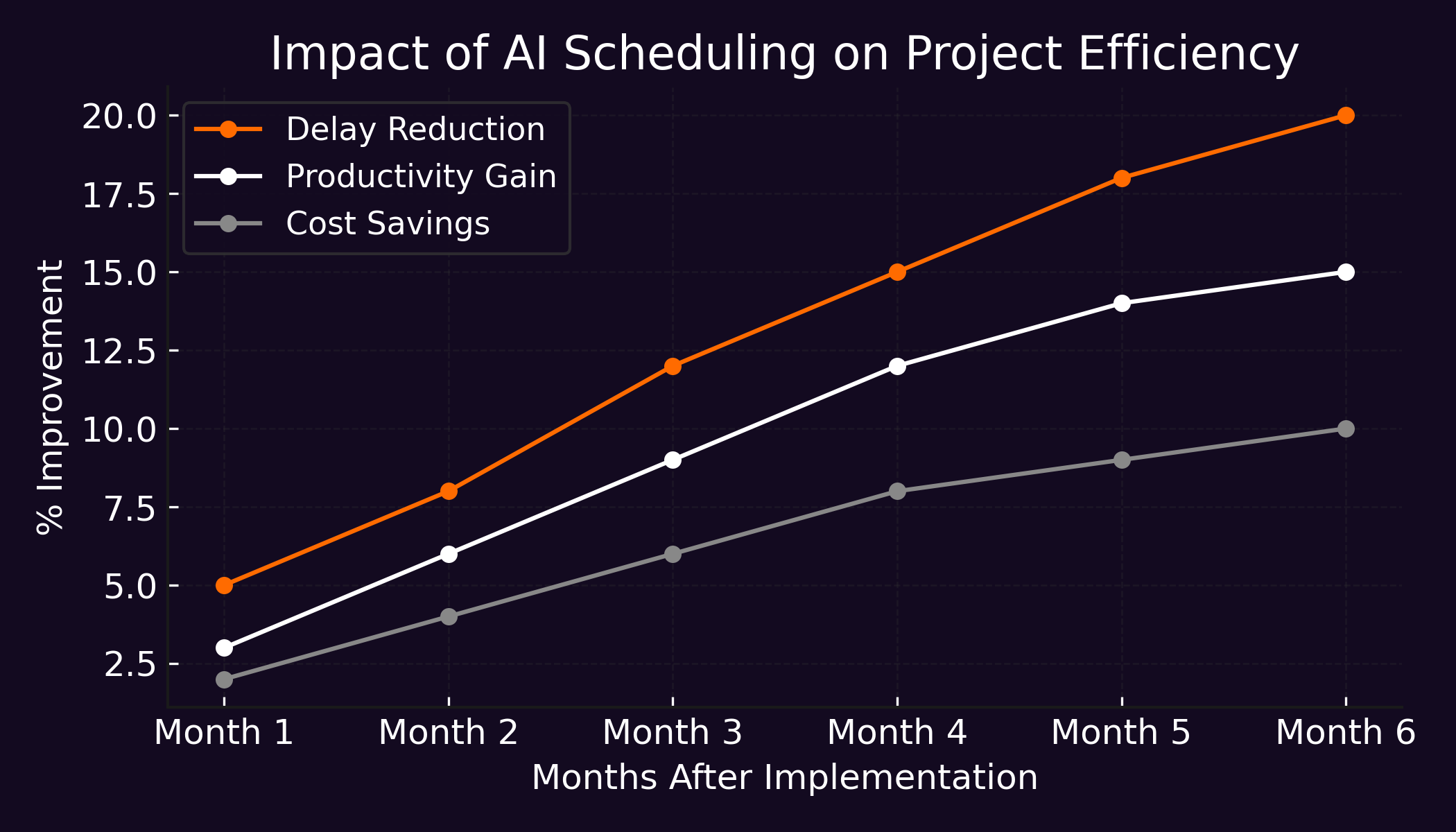🏗️ The Cost of Poor Scheduling
In construction, time is money = and lost time is lost profit.
According to McKinsey & Company (2023), large construction projects typically take 20% longer to complete than scheduled and are up to 80% over budget.
This inefficiency stems from scheduling methods that still depend on static Gantt charts, Excel sheets, and human estimation. These systems can’t capture the dynamic variables of a modern construction site - fluctuating weather, labor availability, and supply chain disruptions.
However, the rise of AI-powered and digital tools is shifting this paradigm. By leveraging predictive analytics, real-time data, and automated rescheduling, construction managers are gaining visibility into every moving part of a project - before problems spiral into delays.
📊 “Why Construction Projects Miss Deadlines”

Y-axis: % of projects
X-axis: Causes of delay
Data Source: KPMG Global Construction Survey, 2024 — Over 52% of delays were linked directly to poor scheduling and coordination errors.
🔍 Why Construction Scheduling Is So Complex
Construction projects are living systems - thousands of interdependent activities must align perfectly in sequence. Each phase depends on material deliveries, subcontractor schedules, inspections, and client approvals.
📌 Common challenges include:
- Frequent delays from unpredictable weather and logistics bottlenecks
- Manual coordination that fails to update dependencies dynamically
- Fragmented data across tools and subcontractors
- Poor visibility into equipment and crew productivity
According to the Construction Industry Institute (CII, 2022), misaligned schedules and poor data integration account for 37% of productivity loss across major construction projects.
Traditional project management tools lack real-time data feedback loops - meaning once a single dependency fails, the entire schedule must be rebuilt manually, often days or weeks later.
🤖 Enter AI & Digital Tools
AI and digital scheduling systems make project management adaptive, predictive, and data-driven.
📌 Here’s how they’re changing the game:
- Predictive Scheduling:
- AI algorithms analyze historical project data to predict risks such as equipment downtime, weather impacts, or material shortages before they occur.
Example: According to Dodge Construction Network (2024), firms using predictive scheduling software reduced average project delays by up to 17%.
- Dynamic Rescheduling:
- When one activity is delayed, the system automatically reassigns crews, shifts dependencies, and updates the Gantt timeline in real-time.
- Conflict Detection:
- AI can detect overlapping tasks, labor overbooking, or missing dependencies that humans might overlook.
- Integrated Dashboards:
- Project managers gain unified visibility across field operations, resource utilization, and cost forecasts - accessible from any device.
📊 “Traditional Scheduling vs AI-Powered Scheduling”

Source: Autodesk Construction Cloud, 2025 - firms adopting AI scheduling reported 28% higher schedule reliability.
🧱 Real-World Applications
📌What are the examples?
- Predicting Equipment Downtime
- A mechanical contractor integrated AI with IoT sensors to monitor equipment vibration patterns. The system forecasted maintenance needs five days in advance - preventing 16 hours of unplanned downtime per week.
- Automated Crew Reallocation
- When a concrete pour was delayed due to heavy rain, the system dynamically reassigned teams to interior prep work, maintaining an 82% productivity rate compared to 63% baseline.
- Multi-Project Coordination
- Large firms managing multiple projects now use AI scheduling to optimize shared resource allocation (e.g., cranes or safety inspectors). This reduced resource conflicts by 31%, based on data from Bentley Systems (2024).
📈 Quantifiable Benefits of AI-Driven Scheduling
- Reduced Delays: Real-time adjustments keep projects on track.
- Higher Productivity: Labor idle time can drop by up to 20%.
- Better Forecasting: Historical data improves future planning accuracy.
- Improved Communication: Digital dashboards replace fragmented email updates.
- Data-Driven Insights: Every schedule change leaves a traceable digital footprint for audit and optimization.
According to ENR (Engineering News-Record, 2024), companies integrating AI scheduling tools reported a 14–20% reduction in project duration and up to 10% cost savings per contract.
📊 “Impact of AI Scheduling on Project Efficiency”

X-axis: Time (Months after implementation)
Y-axis: % Change (Delay Reduction, Productivity Gain, Cost Savings)
Lines show steady improvement trends:
- Blue Line - Delay reduction (↑20%)
- Orange Line - Productivity gain (↑15%)
- Gray Line - Cost savings (↑10%)
Source: ENR Benchmark Report, 2024.
🧠 The Future: AI Resource Planning (ARP) for Construction
At Aden, we call this next evolution AI Resource Planning (ARP) - a system where data, AI, and operational workflows converge to help construction teams plan, simulate, and execute with unprecedented accuracy.
Unlike traditional ERP or scheduling tools, Aden’s ARP connects scheduling, finance, safety, and resource data into one unified environment - making every decision data-driven and traceable.
Imagine asking:
“What happens if the drywall delivery is delayed by two days?”
That’s the power of AI Resource Planning - proactive decision-making instead of reactive adjustments.
📌With Aden, project managers can:
- Simulate project impacts before they occur, using real-time data and AI predictions.
- Automatically rebalance schedules and budgets when delays or resource shortages arise.
- Identify high-risk activities early through predictive analytics and integrated dashboards.
- Align field operations and office teams under one intelligent platform.
By combining scheduling intelligence with financial, operational, and compliance data, Aden’s ARP helps contractors prevent bottlenecks, reduce overruns, and maximize utilization across every project.
📌By contrast, organizations using Aden’s AI Resource Planning platform gain:
- Continuous visibility into project progress and resource health.
- Automated rescheduling when real-world conditions change.
- Predictive forecasting to anticipate risks before they become costly.
- Centralized insights that unify teams, budgets, and operations.